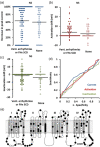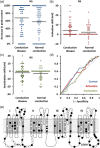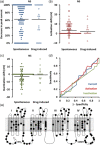Relationship between sodium channel function and clinical phenotype in SCN5A variants associated with Brugada syndrome
- PMID: 33131149
- PMCID: PMC7756571
- DOI: 10.1002/humu.24128
Relationship between sodium channel function and clinical phenotype in SCN5A variants associated with Brugada syndrome
Abstract
The identification of a pathogenic SCN5A variant confers an increased risk of conduction defects and ventricular arrhythmias (VA) in Brugada syndrome (BrS). However, specific aspects of sodium channel function that influence clinical phenotype have not been defined. A systematic literature search identified SCN5A variants associated with BrS. Sodium current (INa ) functional parameters (peak current, decay, steady-state activation and inactivation, and recovery from inactivation) and clinical features (conduction abnormalities [CA], spontaneous VA or family history of sudden cardiac death [SCD], and spontaneous BrS electrocardiogram [ECG]) were extracted. A total of 561 SCN5A variants associated with BrS were identified, for which data on channel function and clinical phenotype were available in 142. In the primary analysis, no relationship was found between any aspect of channel function and CA, VA/SCD, or spontaneous BrS ECG pattern. Sensitivity analyses including only variants graded pathogenic or likely pathogenic suggested that reduction in peak current and positive shift in steady-state activation were weakly associated with CA and VA/SCD, although sensitivity and specificity remained low. The relationship between in vitro assessment of channel function and BrS clinical phenotype is weak. The assessment of channel function does not enhance risk stratification. Caution is needed when extrapolating functional testing to the likelihood of variant pathogenicity.
Keywords: Brugada; patch clamp; risk stratification; sodium current.
© 2020 The Authors. Human Mutation Published by Wiley Periodicals LLC.
Conflict of interest statement
The authors declare that there are no conflict of interests.
Figures



References
-
- Amin, A. S. , Verkerk, A. O. , Bhuiyan, Z. A. , Wilde, A. A. , & Tan, H. L. (2005). Novel Brugada syndrome causing mutation in ion‐conducting pore of cardiac Na+ channel does not affect ion selectivity properties. Acta Physiologica Scandinavica, 185(4), 291–301. 10.1111/j.1365-201X.2005.01496.x - DOI - PubMed
-
- Baroudi, G. , Pouliot, V. , Denjoy, I. , Guicheney, P. , Shrier, A. , & Chahine, M. (2001). Novel mechanism for Brugada syndrome: Defective surface localization of an SCN5A mutant (R1432G). Circulation Research, 88(12), E78–E83. - PubMed
-
- Bezzina, C. R. , Barc, J. , Mizusawa, Y. , Remme, C. A. , Gourraud, J. B. , Simonet, F. , Verkerk, A. O. , Schwartz, P. J. , Crotti, L. , Dagradi, F. , Guicheney, P. , Fressart, V. , Leenhardt, A. , Antzelevitch, C. , Bartkowiak, S. , Borggrefe, M. , Schimpf, R. , Schulze‐Bahr, E. , Zumhagen, S. , … Redon, R. (2013). Common variants at SCN5A‐SCN10A and HEY2 are associated with Brugada syndrome, a rare disease with high risk of sudden cardiac death. Nature Genetics, 45(9), 1044–1049. 10.1038/ng.2712 - DOI - PMC - PubMed
-
- Campuzano, O. , Sarquella‐Brugada, G. , Fernandez‐Falgueras, A. , Cesar, S. , Coll, M. , Mates, J. , Arbelo, E. , Perez‐Serra, A. , del Olmo, B. , Jordá, P. , Fiol, V. , Iglesias, A. , Puigmulé, M. , Lopez, L. , Pico, F. , Brugada, J. , & Brugada, R. (2019). Genetic interpretation and clinical translation of minor genes related to Brugada syndrome. Human Mutation, 40, 749–764. 10.1002/humu.23730 - DOI - PubMed
Publication types
MeSH terms
Substances
Grants and funding
LinkOut - more resources
Full Text Sources
Miscellaneous

